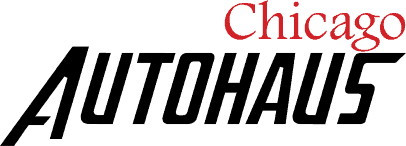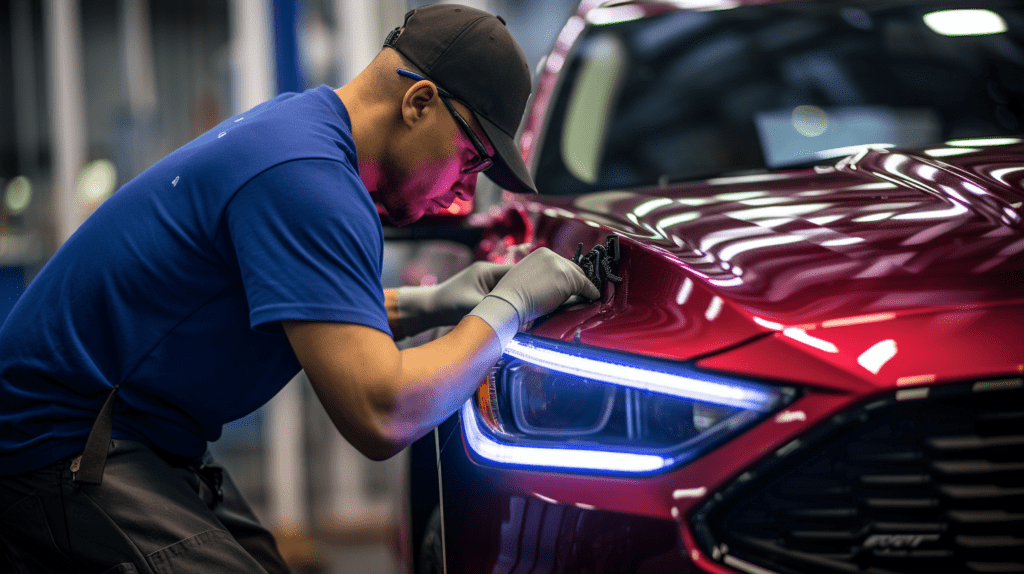
When it comes to Ford Fusion collision repair, there are several key factors to consider.
Firstly, it’s important to use a Ford Certified Collision Network (FCCN) repair center. These centers are certified by Ford and receive annual on-site assessments and up-to-date repair support directly from Ford Motor Company. This ensures that your Ford vehicle repair meets the highest standards of excellence[7]. You can find a Ford Certified Collision Network repair center near you on the Ford website[3].
The repair process should follow Ford’s OEM (Original Equipment Manufacturer) guidelines. These guidelines cover various aspects of collision repair, including body construction materials identification, repair guidelines, foams, sealers, and adhesive locations and product requirements, structural sectioning procedures, outer body panel sectioning procedures, and corrosion protection methods and materials[1].
The cost of repair can vary depending on the extent of the damage. The average annual repair cost for a Ford Fusion is $581[2]. However, specific collision repair costs can range from $200 to $2,000 for front-end or rear-end repairs, and up to $10,000 for frame repair[6]. If you have a Ford Protect Extended Service Plan, it provides up to 10 days of rental benefits when a vehicle is kept overnight for a covered repair[8].
It’s also important to understand your insurance policy. Check your policy for information about OEM parts coverage. Your insurer cannot force certain repair parts on you; it is your right to have your vehicle repaired with new OEM parts.
Finally, if you need a rental car during the repair process, your service advisor may offer you a rental once the cause of the failure has been diagnosed. Basic rental benefits can be used if a vehicle must be kept overnight to complete a covered repair.
In conclusion, when planning for a Ford Fusion collision repair, it’s crucial to use a certified repair center, follow OEM guidelines, understand the potential costs, know your insurance policy, and arrange for a rental car if necessary.
Key Takeaways
- Understanding the complex electrical systems and advanced safety features of the Ford Fusion is crucial for effective collision repair.
- Thorough inspection and consideration of hidden damage are important when assessing the damage and developing a repair plan for the Ford Fusion.
- The selection of genuine Ford parts is important, but aftermarket options can be considered when genuine parts are not available.
- Implementing advanced repair techniques, such as laser measuring systems and adhesive bonding, is essential to restore the Ford Fusion to its original factory specifications.
Understanding Ford Fusion’s Collision Repair Challenges
Three major collision repair challenges are commonly encountered when working on the Ford Fusion. Understanding these challenges is crucial for effective and efficient repair processes. The first challenge lies in the complex electrical systems and advanced safety features integrated into the vehicle. The Ford Fusion is equipped with sophisticated sensors, cameras, and computer systems that require extensive diagnostic tools and expertise to identify and repair any malfunctions or damages accurately.
The second challenge is related to the vehicle’s lightweight construction. The Ford Fusion incorporates high-strength steel and lightweight materials to enhance fuel efficiency and performance. However, this design poses challenges in repairing structural damages as it requires specialized techniques and equipment to ensure proper alignment and structural integrity.
Lastly, the Ford Fusion’s unique design elements, such as its aerodynamic body shape and intricate grille design, can present challenges during the repair process. Matching paint colors and restoring the vehicle’s original aesthetics require skilled technicians who possess a keen eye for detail and precise color-matching capabilities.
To overcome these challenges, collision repair technicians working on Ford Fusion vehicles need to stay updated with the latest repair techniques and have access to comprehensive repair manuals and manufacturer-approved repair procedures. Additionally, investing in advanced diagnostic tools and equipment specific to the Ford Fusion can significantly improve the efficiency and accuracy of repairs, ensuring customer satisfaction and safety.
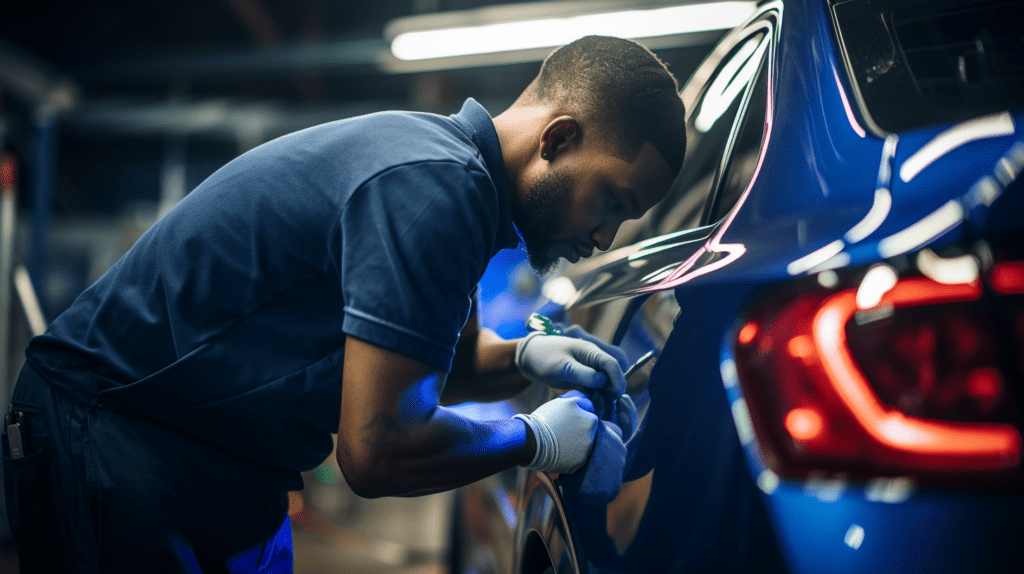
Assessing Damage and Developing a Repair Plan
When assessing damage and developing a repair plan for the Ford Fusion, collision repair technicians must carefully analyze the extent of the damage and consider the specific challenges posed by the vehicle’s complex electrical systems, lightweight construction, and unique design elements. In order to accurately assess the damage, technicians should conduct a thorough inspection of the vehicle’s structural components, body panels, and mechanical systems. This will help identify any hidden damage that may not be immediately visible. Additionally, technicians need to be aware of the Fusion’s lightweight construction, which incorporates high-strength steel and aluminum alloys, as this can impact the repair process.
To develop an effective repair plan, technicians should utilize manufacturer repair guidelines and procedures for the Ford Fusion. These guidelines provide detailed instructions on how to repair specific parts and systems, ensuring that the vehicle is restored to its pre-accident condition. It is crucial to consider the complexity of the Fusion’s electrical systems during the repair process. This includes properly diagnosing and addressing any electrical issues that may have been caused by the collision.
Developing estimates for the repair costs is another important aspect of the repair planning process. Technicians should consider the cost of replacement parts, labor, and any additional repairs that may be required due to the extent of the damage. By accurately assessing the damage and developing a comprehensive repair plan, collision repair technicians can ensure that the Ford Fusion is restored to its original condition while maintaining safety and performance standards.
Selecting the Right Parts for Ford Fusion Repairs
To ensure a successful repair for the Ford Fusion, collision repair technicians must carefully select the appropriate parts, considering the vehicle’s unique design and materials. When it comes to parts selection, there are several factors to keep in mind. First and foremost, it is crucial to use genuine Ford parts whenever possible. These parts are specifically designed and engineered for the Fusion, ensuring the best fit, performance, and longevity. Genuine Ford parts also come with a warranty, giving both the repair shop and the customer peace of mind.
However, in some cases, genuine parts may not be readily available or may come at a higher cost. In these situations, collision repair technicians may consider aftermarket options. Aftermarket parts are produced by third-party manufacturers and are often more affordable than genuine parts. However, it is essential to carefully evaluate the quality and compatibility of aftermarket parts before using them in a repair. Some aftermarket parts may not meet the same standards as genuine parts and may not provide the same level of fit, performance, or durability.
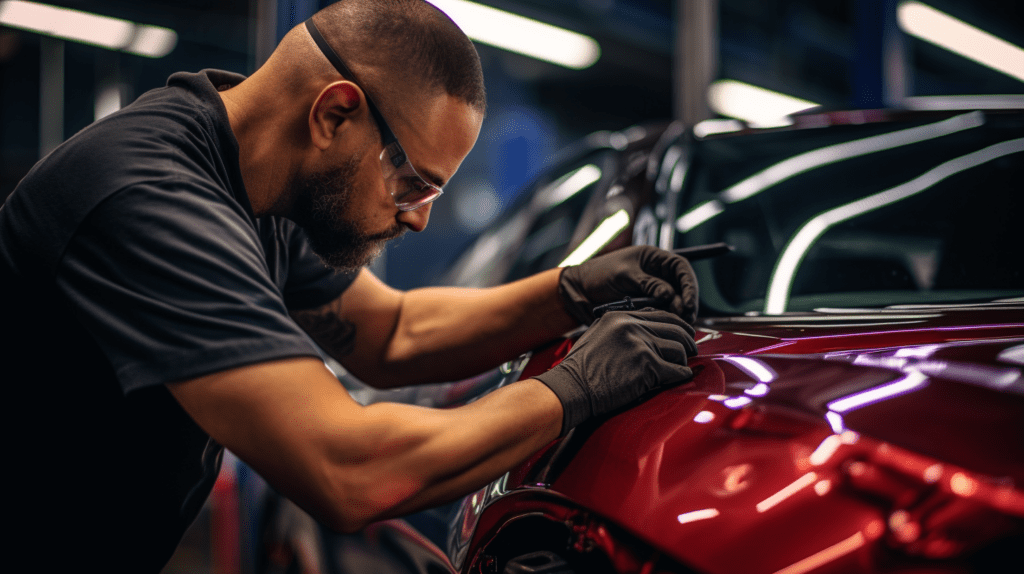
To assist collision repair technicians in selecting the right parts for Ford Fusion repairs, the table below outlines some key considerations for both genuine and aftermarket parts:
| Consideration | Genuine Parts | Aftermarket Parts |
|---|---|---|
| Quality | High | Varies |
| Fit | Excellent | Varies |
| Performance | Optimal | Varies |
| Warranty | Yes | Varies |
| Cost | Higher | Lower |
Implementing Advanced Repair Techniques for the Fusion
Advanced repair techniques can enhance the efficiency and effectiveness of collision repairs for the Ford Fusion. When implementing advanced repair techniques, it is crucial to consider the specific requirements of the Fusion to ensure accurate and reliable repairs. Fusion repair strategies should include a combination of traditional repair methods and advanced techniques to achieve the best results.
One advanced repair technique for the Fusion is the use of laser measuring systems. These systems provide precise measurements of the vehicle’s dimensions, allowing technicians to accurately identify and correct any structural misalignments caused by the collision. By using laser measuring systems, repair professionals can ensure that the Fusion is restored to its original factory specifications.
Another advanced repair technique is the use of aluminum repair procedures. The Fusion incorporates aluminum components in its design, which require specific techniques for repair. Aluminum repair procedures involve specialized tools and equipment, as well as training for technicians to correctly handle and repair aluminum parts. By implementing these procedures, repair professionals can effectively repair the Fusion’s aluminum components without compromising their structural integrity.
Furthermore, advanced repair techniques for the Fusion may include the use of adhesive bonding and welding techniques. These methods are utilized to repair damaged panels or structural components, ensuring a strong and durable repair. Adhesive bonding provides a seamless repair, reducing the risk of corrosion and improving the overall appearance of the vehicle.
Ensuring Quality and Efficiency in Ford Fusion Collision Repairs
With a focus on maintaining high standards of quality and efficiency, collision repairs for the Ford Fusion can be effectively executed. Maximizing customer satisfaction and streamlining repair processes are key objectives in ensuring that repairs are completed to the highest standard while minimizing downtime and costs.
To achieve maximum customer satisfaction, collision repair technicians need to be well-trained and equipped with the necessary skills and knowledge to handle repairs on the Ford Fusion. This includes understanding the specific structural and safety features of the vehicle, as well as being familiar with the latest repair techniques and technologies. By staying up-to-date with training and certifications, technicians can confidently address any collision damage and provide customers with the reassurance that their vehicle is in capable hands.
Streamlining repair processes is essential to ensure that repairs are completed efficiently and in a timely manner. This involves effective communication and coordination between the repair facility, insurance companies, and parts suppliers. By utilizing digital tools and software, such as computerized estimating systems and electronic parts ordering, repair facilities can minimize delays and errors in the repair process. Additionally, implementing lean principles, such as optimizing workflow and eliminating waste, can help improve efficiency and reduce repair cycle time.
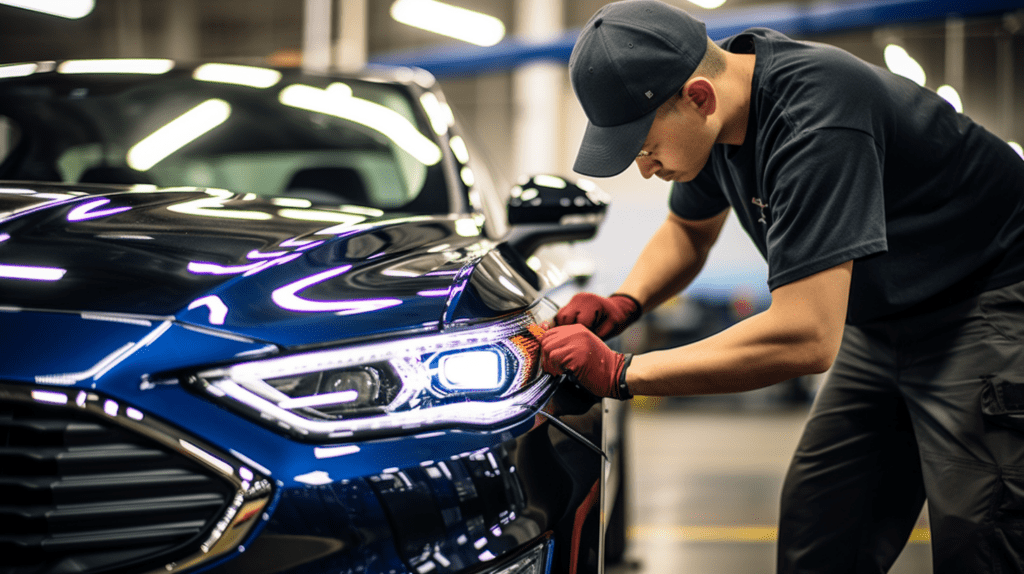
Frequently Asked Questions
What is the Ford Certified Collision Network (FCCN)?
The Ford Certified Collision Network (FCCN) is a group of repair centers certified by Ford to ensure that your Ford vehicle repair meets the highest standards of excellence. These centers receive annual on-site assessments and up-to-date repair support directly from Ford Motor Company.
How much does a Ford Fusion collision repair cost?
The cost of a Ford Fusion collision repair can vary depending on the extent of the damage. The average annual repair cost for a Ford Fusion is $581. However, specific collision repair costs can range from $200 to $2,000 for front-end or rear-end repairs, and up to $10,000 for frame repair.
Can I choose any repair shop for my Ford Fusion collision repair?
You can choose any repair shop for your Ford Fusion collision repair, but it’s recommended to use a Ford Certified Collision Network (FCCN) repair center to ensure that your vehicle is repaired to Ford’s original manufacturer specifications.
Will my insurance cover the cost of a rental car while my Ford Fusion is being repaired?
Whether your insurance will cover the cost of a rental car while your Ford Fusion is being repaired depends on your specific policy. If you have rental car and travel reimbursement coverage, your insurance can help cover the cost of a rental car.
How can I ensure that the repairs on my Ford Fusion meet safety standards and are of high quality?
To ensure that the repairs on your Ford Fusion meet safety standards and are of high quality, it’s recommended to use a Ford Certified Collision Network (FCCN) repair center. These centers receive yearly audits to ensure they meet the current standards required by the brand. Additionally, you can refer to Ford’s collision repair technical articles and bulletins, position statements, and repair instructions for more information.
Citations: [1] https://rts.i-car.com/oem-information/ford.html [2] https://repairpal.com/ford/fusion [3] https://collision.ford.com/find-a-certified-center [5] https://collision.ford.com/auto-repairs [7] https://collision.ford.com/certified-centers [8] https://fordprotect.ford.com/extended-service-plan [9] https://rts.i-car.com/oem-partial-part-replacement-search/prm-8495.html [10] https://www.reddit.com/r/fordfusion/comments/13xn1ar/body_cost_estimate/ [12] https://www.f150forum.com/f118/warranty-rental-charge-no-charge-410064/ [13] https://collision.ford.com/assets/files/FCCNCertificationRequirementsSummary.pdf [14] https://community.cartalk.com/t/repair-estimate-on-my-ford-fusion/152939 [16] https://collision.ford.com [17] https://www.kbb.com/ford/fusion/2013/auto-repair/ [18] https://www.planetford635.com/body-shop/ [19] https://www.ford.com/support/category/service-maintenance/ford-collision-parts/ [20] https://www.withclutch.com/maintenance-cost/ford-fusion [22] https://www.repairerdrivennews.com/2020/10/14/free-ford-resources-for-body-shops-include-parts-diagrams-owners-manuals/ [23] https://www.yourmechanic.com/estimates/ford/fusion [24] https://fordcrashparts.com [25] https://fordfusionhybridforum.com/topic/13740-collision-repair-costs-of-ford-fusion-2010-hybrid/
